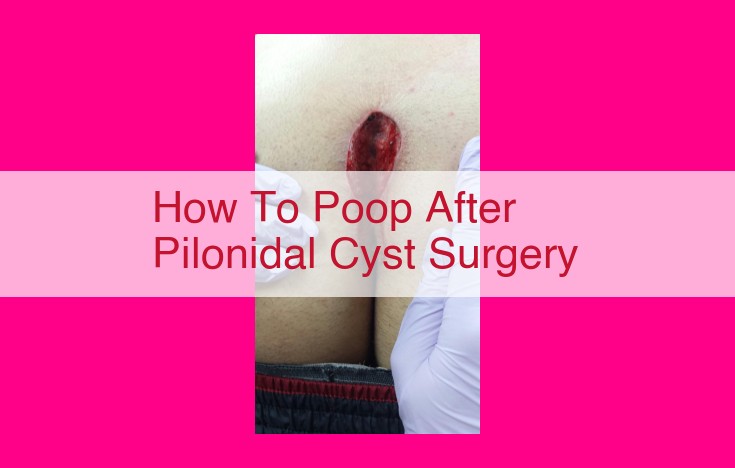Post-Pilonidal Cyst Surgery: Essential Guide To Optimal Recovery And Bowel Management

After pilonidal cyst surgery, proper defecation is crucial. Maintain bowel regularity through diet and laxatives if needed. Manage pain with prescribed analgesics. Keep the incision clean and dry with appropriate dressings and sitz baths. Adopt proper posture, exercise regularly, and manage stress to aid healing. Healthcare providers will monitor progress through follow-ups. Utilize toilet seat cushions for added comfort and wound protection. By adhering to these guidelines, individuals can effectively manage bowel function and promote optimal post-operative recovery.
Post-Operative Care: Medical Considerations
After undergoing surgery, your body goes through a healing process. Understanding and adhering to post-operative medical guidelines is crucial for a smooth recovery. Here are some key considerations:
Bowel Function and Regularity
Regaining regular bowel movements after surgery is essential. Constipation can be a common issue, so maintaining a balanced diet and staying hydrated is vital. Incorporate fiber-rich foods like fruits, vegetables, and whole grains into your meals. Additionally, consider using stool softeners or laxatives as prescribed by your doctor to facilitate easier bowel movements.
Pain Management and Medication
Post-operative pain is managed with analgesics (pain relievers). Your doctor will prescribe appropriate medications to alleviate discomfort. Follow the prescribed dosage and schedule carefully to ensure effective pain relief.
Antibiotics and Dietary Recommendations
Antibiotics may be prescribed to prevent or treat infections after surgery. It’s essential to take these medications as directed and complete the entire course to prevent antibiotic resistance. In certain cases, dietary recommendations may be given to support healing. For instance, after gastrointestinal surgery, a low-residue diet may be recommended to reduce digestive stress. Always consult your doctor for specific dietary guidelines.
Wound Care for a Speedy and Seamless Recovery
After surgery, meticulous wound care is paramount for optimal healing and a swift recovery. Here’s a comprehensive guide to ensure your incision site receives the proper care it needs:
Cleaning and Dressing Instructions
Keep your incision clean by gently washing it daily with mild soap and water. Use a clean washcloth or gauze to avoid introducing bacteria. Pat the area dry with a fresh towel.
Your doctor will provide specific dressing instructions based on the type of surgery you underwent. Follow these instructions carefully, changing the dressing as recommended. Remember to keep the incision dry and protected from friction.
Wound Dressings: A Protective Shield
Wound dressings play a crucial role in protecting the incision from external contaminants and promoting healing. They absorb drainage and create a moist environment conducive to tissue repair. Different types of dressings available include:
- Gauze pads: Simple and effective for covering small incisions.
- Hydrocolloid dressings: Adhesive dressings that provide a moist environment and promote healing.
- Transparent film dressings: Durable and waterproof, allowing you to monitor the incision without removing the dressing.
Sitz Baths: A Soothing Elixir for Wound Healing
Sitz baths involve sitting in warm water for 10-15 minutes. They promote circulation, reduce swelling, and soothe the incision site. Add Epsom salts to the water for their antibacterial and anti-inflammatory properties. Take sitz baths as recommended by your doctor.
Lifestyle Modifications for Post-Operative Care
After surgery, it’s crucial to adopt certain lifestyle modifications to promote healing and recovery. Maintaining proper posture is paramount to prevent undue strain on the surgical site. Avoid slouching and keep your spine straight, minimizing pressure on the incision. Engage in light exercise, as recommended by your doctor, to enhance blood circulation and facilitate faster healing.
Manage stress levels effectively, as stress can hinder the healing process. Incorporate relaxation techniques into your daily routine, such as yoga, meditation, or deep breathing exercises. Maintaining a positive and stress-free mindset can significantly contribute to your overall well-being and recovery.
Other Essentials:
- Discuss the role of health care providers, including scheduled follow-up appointments.
- Dedicate a section to sitz baths, explaining their benefits, frequency, and duration.
- Explain the purpose and use of toilet seat cushions specifically designed for post-operative care.
Other Essentials for Post-Operative Recovery
The Role of Healthcare Providers
After surgery, you’ll have a team of healthcare providers monitoring your progress and providing necessary support. Regular follow-up appointments are crucial for assessing your healing, adjusting medications, and addressing any concerns. Don’t hesitate to communicate with your doctor or nurse if you experience any issues or have questions.
Sitz Baths: Soaking for Healing
Sitz baths are warm water baths designed to promote healing and relieve discomfort in the genital and anal areas after surgery. They can help reduce inflammation, ease pain, and encourage circulation. Fill a shallow tub with warm water and sit for 10-15 minutes at a time, 2-3 times a day.
Toilet Seat Cushions: Comfort and Support
Toilet seat cushions provide additional support and cushioning for the sensitive area after surgery. They can help reduce pressure on the incision site, making sitting more comfortable. Choose cushions made of soft, breathable materials that are specifically designed for post-operative care.